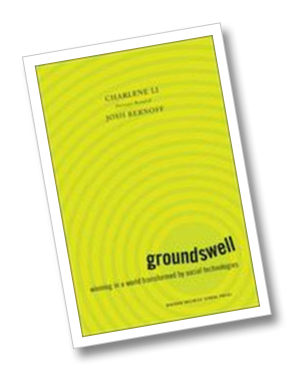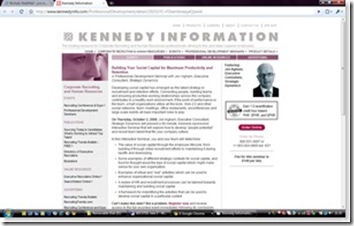I've been meaning to post on
'Groundswell' for some time. This book, written by two analysts who were both at
Forrester, provides an interesting contrast to
Gartner's warnings on hype.
Li and Bernoff believe that the evolution of social computing is creating a permanent, long-lasting shift in the way the world works, in which people use technologies to get things from each other instead of from companies.
I'm still not really sure how deep this shift will be, but I do agree with the authors that the phenomenon is actually about people "acting on their eternal desire to connect", so in order to master the groundswell, companies need to "concentrate on the relationships, not the technologies":
"Companies often approach Social Computing as a list of technologies to be deployed as needed — a blog here, a podcast there — to achieve a marketing goal. But a more coherent approach is to start with your target audience and determine what kind of relationship you want to build with them, based on what they are ready for."
The technologies are being adopted quickly simply because they make connections and relationships more interesting, more varied and more frequent. Which technologies will work will depend upon the participants' 'social technographics profile' which consists of the following groups:
- Creators. The profile tool on Forrester's website suggests that only 12% of 34-44 year olds in the UK are creators, who like me, publish a blog or own web pages.
- Critics (22% of this demographic)
- Collectors (8%)
- Joiners (19%)
- Spectators (48%)
- Inactives (43%)
The groundswell inside your company
Although the book focuses on dealing with customers, the points it makes apply equally to dealing with employees and three examples are provided: Best Buy's internal community site Blue Shirt Nation; Avenue A / Razorfish's wiki; and Bell Canada's idea exchange, ID-ah!; as well as Ernst & Young's graduate recruitment site on Facebook.
To make these approaches work, employees need to know that "managers will listen to their openly contributed opinions, rather than punishing dissenters". So organisations need to "promote a listening culture from the top down, ease and encourage participation with incentives, and find and empower the rebels in your organisation".
It's about changing the way organisations work. And management involvement and active participation is crucial:
"We recall one puzzled professional services company that approached us with a conundrum. It had deployed blogs, wikis and social networking tools internally, specifically targeting newly hired college grads who all said they were very familiar with these tools. Yet several months into the rollout, there was hardly any participation. Why not? Because the company had deployed the technologies with little management sponsorship or involvement."
However, social technologies can't be forced on organisations from the top down, "because by their definition, these technologies require the participation of your employees".
Developing strategy
To help focus on the relationships, the books suggests a four-step planning process (POST) to develop strategy for dealing with this area:
- People - what are your customers ready for (using the social technographics profile)?
- Objectives - what are your goals (listening, talking, energising, supporting or embracing - eg through crowdsourcing)?
- Strategy - how do you want relationships with your customers to change?
- Technology - finally, what applications should you build?
The authors note that this could equally be OPST (just don't start with the T!). To me, which of the two options will work best will depend on the type of value you want to create (see the value triangle). To add value to an existing business objective, use OPST. To create value from people, look for the opportunities inherent in your people first, hence POST.
And the only change I would suggest to the process would be using A rather than T where A stands for activity, and can include any real or virtual activity / technology. Relationships don't always need the use of technology to be enhanced.
Best fit in social capital
One of the many interesting points made by the book, which echoes my own thinking about HCM, is the need to find a best fit between strategy and organisational needs:
"Each tactic must adopt the tactics that are right for its customers and its way of doing business and adapt as the technologies change. Copying others doesn't work because your company, your customers, and your goals are not the same as anybody else's."
So I think that when thinking about social capital, ie the value of an organisation's connections and relationships, we need to find a best fit too. Do you want this capital to be based upon listening, talking, energising, supporting or embracing, and what content do you want these relationships to focus on?
And I think there is an interesting dilemma / paradox here. How do you influence the nature / content of your social capital, when you can't direct the use of social technologies from the top down?
Sorry this review is so behind the times (Groundswell having already ben out for several months). But at the moment, I am using this blog to help me catch up on the social computing as well as social capital scene. So I've got some book reviews of even older books coming up.
It's going to be a few more months before this blog starts to provide much in the way of new thinking, rather than commentating on existing thinking. But stay with me!





















